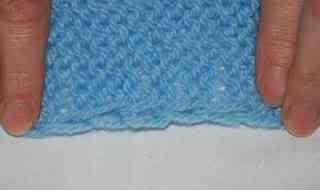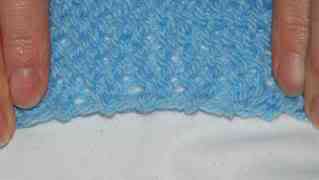The first thing to remember about a selvage edge is that you don’t have to do one if you don’t want to! Many knitters never bother with a selvage edge and their knitting doesn’t seem to suffer any terribly consequences as a result! However, others swear by a selvage, arguing that it looks neater and makes the whole process of making up the garment at the end easier and quicker. So what is a selvage edge? A selvage edge (also known as a selvedge edge) is a special
edging worked on one or both sides of a piece of knitting. It has two purposes. Firstly, it can create a neat or decorative finish to an edge which is going to be left unattached to anything else–for example, the sides of a scarf. Secondly, a selvage edge can provide a handy edge for sewing up when two pieces are going to be joined together to form a seam.
There are several ways to form a selvage edge. With simple patterns, you may feel that you don’t need a selvage at all, but with more complicated patterns it can be difficult to match up the rows when you are making up the garment. In these cases a selvage can give you a nice neat edge of even stitches making it easier to sew up.
If your pattern does not include a selvage and you wish to add one, remember to add two stitches when you are casting on. These two stitches will form your selvage edges–one each side of the knitting. If you don’t add the stitches then your pattern may go wrong because you will be knitting it over the wrong number of stitches. Remember that your first and last stitch are your selvage edges so you will knit the first stitch, follow the pattern, including any decreases or increases, then knit the final stitch.
Two useful selvage edges are shown below. The examples in the photographs are worked in stocking stitch, but the reverse of the fabric is shown as the selvage edges tend naturally to curl inwards. You will need to press the edges beneath a damp cloth to flatten them. (I haven’t pressed them in the picture as it tends to flatten the stitches making them more difficult to see.)
Chain stitch selvage

This selvage leaves a chain stitch effect down the side of the knitting. It is the simplest of all selvages and gives a nice, decorative finish to an open edge. Some people also like to use this selvage when joining two pieces together as the large loops are easy to see. Other people feel that the large loops are too big and can leave small holes in the seam. It really is a matter of preference.
The chain stitch selvage is formed very simply by slipping the first stitch of each row. To slip a stitch you simply put the right hand needle through the first stitch on the left hand needle, just as if you were about to knit it, but instead of winding the wool round to form the stitch you slip the stitch straight onto the right hand needle without knitting it.
You then knit the second stitch according to the pattern. It’s best to slip the stitch as it comes. In other words, on a knit row, put the needle in as if you were going to knit the stitch, then slip it over. On a pearl row put the needle in as if you were going to do a pearl stitch then slip it over. (This is called slipping pearl wise.) If you are knitting anything other than stocking stitch then assume the front of the garment is the knit row and the back is the pearl row.
This method means that you are only working the end stitches once every other row and this is why you get the nice loopy pattern, where each stitch stretches over two rows.
Knotted edge selvage

This selvage edge is really useful if you are knitting a complicated pattern and are going to have to join seams to make the finished garment.
The edge has even knots all the way up every other row, making it really easy to keep count of your rows. You can match the pieces row for row, or, if you are required to ease two different length pieces together you can work out the ratio of rows and use the knots to keep count.
Once again, you need to add two stitches when you cast on if the pattern doesn’t include a selvage, then work the edges as follows.
With the right side of the knitting facing you, draw the yarn towards you, then push the right hand needle in to the first stitch on the left hand needle as if you were going to work a pearl stitch. Slip that stitch straight onto the right hand needle. Now take the yarn between the needles so that it is laying on the side of the knitting furthest from you, and carry on knitting. At the end of the row, knit the last stitch. On the next row pearl the first and last stitch. Repeat these instructions every two rows.
Easy as that!
Further Reading and Additional Resources
A perfect beginner’s guide and all-around excellent reference that I highly recommend you acquire is The Knitting Answer Book: Solutions to Every Problem You’ll Ever Face; Answers to Every Question You’ll Ever Ask by Margaret Radcliffe, it’s pretty popular so you can order it there from Amazon or you could probably find it at your local bookstore.